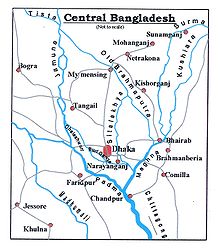Buriganga River
| Buriganga River | |
|---|---|
 A launch sails from Sadarghat on the Buriganga | |
 | |
| Native name | বুড়িগঙ্গা নদী (Bengali) |
| Location | |
| Country | Bangladesh |
| City | Dhaka |
| Physical characteristics | |
| Source | Dhaleshwari River |
| • location | near Kalatia |
| Mouth | Dhaleshwari River |
• location | about 3 km (2 mi) southwest of Fatullah |
| Length | 18 km (11 mi)[1] |
The Buriganga (Bengali: বুড়িগঙ্গা, Buŗigônga, lit. 'Old Ganges') is a river in Bangladesh which flows past the southwest outskirts of the capital city, Dhaka. Its average depth is 7.6 metres (25 ft) and its maximum depth is 18 metres (58 ft). It ranks among the most polluted rivers in the country.[2][3]
Dhaleshwari River

According to R. C. Majumdar, in the distant past, a course of the Ganges river probably used to reach the Bay of Bengal through the Dhaleshwari River. The Buriganga originated from the Dhaleshwari in the south of Savar, near Dhaka [4] In the 20th century the water table and river became polluted by polythenes[clarification needed] and other hazardous substances from demolished buildings near the river banks.
The Buriganga is economically very important to Dhaka. Launches and country boats provide connection to other parts of Bangladesh, a largely riverine country. When the Mughals made Dhaka their capital in 1610, the banks of the Buriganga were already a prime location for trade. The river was also the city's main source of drinking water.
Pollution
Today, the Buriganga river is afflicted by pollution. The chemical waste of mills and factories, household waste,
Nearly 4.0 million people of the city are exposed to the consequences of water pollution every day.[citation needed]
Gallery
-
Large launches waiting atSadarghaton the Buriganga for different destinations in Bangladesh
-
A boatman sells pineapples at Sadarghat on the Buriganga
-
Sadarghat port on the Buriganga River, Dhaka city
-
Sadarghat port on the Buriganga river is an important river transport hub
-
Small boats ply on the Buriganga at Sadarghat
-
Land reclamation on the Buriganga river dredges sand and deposits it on the floodplain.
-
Evening of Buriganga River, Dhaka, Bangladesh
-
Sunset of Buriganga River
-
Launch
See also
References
- ^ "Burigunga River". Burigunga Riverkeeper. Archived from the original on 28 August 2013. Retrieved 13 October 2014.
- ^ Majumder, Azad (19 May 2009). "Bangladesh river pollution threatens millions". Reuters. Retrieved 9 January 2020.
- ^ "The river runs black: pollution from Bangladesh's tanneries – in pictures". the Guardian. 23 October 2015. Retrieved 9 January 2020.
- OCLC 961157849..
- ^ "Pollution control and tannery relocation". Leather International. Global Trade Media. 25 October 2002. Retrieved 22 February 2017.
- ^ "Toxic Tanneries: The Health Repercussions of Bangladesh's Hazaribagh Leather". Human Rights Watch. 8 October 2012. Retrieved 22 February 2017.
- ^ Aulakh, Raveena (12 October 2013). "Bangladesh's tanneries make the sweatshops look good". Toronto Star. Retrieved 22 February 2017.
- ^ "Dhaka's looming water crisis". The Financial Express (Editorial). Dhaka. Archived from the original on 10 March 2005.
- ^ Bain, Marc. "Fast fashion is causing an "environmental emergency"". Quartz. Retrieved 9 January 2020.
- ^ Webber, Kathleen (22 March 2017). "How Fast Fashion Is Killing Rivers Worldwide". EcoWatch. Retrieved 9 January 2020.
- Chowdhury, Sifatul Quader (2012). "Buriganga River". In Islam, Sirajul; Jamal, Ahmed A. (eds.). Banglapedia: National Encyclopedia of Bangladesh (Second ed.). Asiatic Society of Bangladesh.









